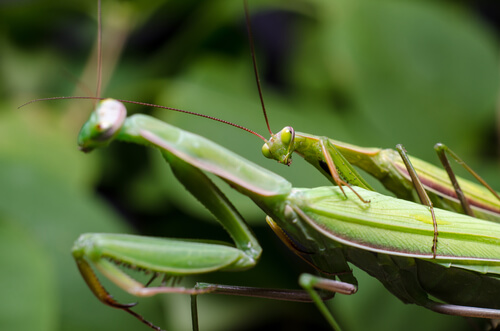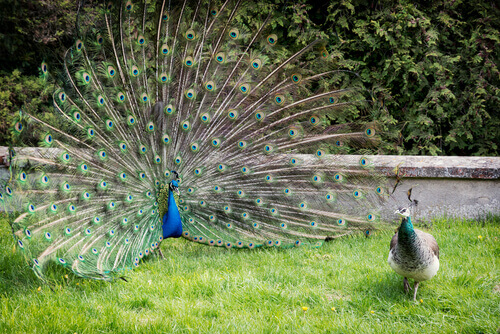Exploring Sexual Dimorphism: 5 Impressive Examples

Sexual dimorphism is the name given to the situation when males and females of the same species look radically different. Generally speaking, this differentiation is triggered by the process of sexual selection through competitive mating. Keep reading as we delve into the task of exploring sexual dimorphism today!
The manifestation of sexual dimorphism can occur in many ways: differences in size, coloration, behavior, and the presence of secondary sexual characteristics such as tail feathers or antlers.
Although humans have a relatively low degree of sexual dimorphism, other species can exhibit quite extreme differences. Here we’ll see some examples of species with a high degree of sexual dimorphism.
Exploring sexual dimorphism
As already mentioned, sexual dimorphism refers to all the physical differences that a species manifests between male and female. These characteristics can sometimes be very evident, although, in some cases, they go completely unnoticed.
The origin of sexual dimorphism is found in sex hormones. Due to their biology, each sex produces a different scheme of hormones, which generates diverse physiological changes. For this reason, most of the dimorphic characteristics appear when a species matures sexually. However, other factors such as diet, genetics, and environment also impact the physical changes of the specimen.
Types of sexual dimorphism
Depending on the characteristics that are affected, when exploring sexual dimorphism, we can classify into different types. Among the most common are the following:
- One of the sexes is larger than the other.
- Differences in the pattern or intensity of light emitted. Here we have the specific case of fireflies.
- Physical differences in defense characteristics. Females have extra trait(s) that allow them to better defend their young.
- When each sex has different sound patterns. This occurs in both birds and amphibians, which use their vocalizations for courtship.
- Differences in the color of each sex. Males usually have more striking colors to attract females. It occurs mainly in birds, but some reptiles and arthropods may also exhibit it.
What advantages can sexual dimorphism provide in a species?
Sexual dimorphism is actually an evolutionary advantage that helps the species to improve its lineage. For this reason, animals invest a great deal of energy and resources in developing their dimorphic characteristics. Some of the advantages provided by these differences are the following:
1. It influences sexual selection
This concept refers to the preference of certain sexual partners for mating. If an individual is chosen, it will increase its chance of reproduction. Some traits have the function of increasing individual attractiveness, such as brightly colored feathers or fur. These traits come at a high cost to the animal.
In this sense, exaggerated traits, while favoring attractiveness, increase exposure to predators. Males bear this cost.
In the end game of evolution, it’s often more important to reproduce and pass on your genes than to have long-term survival.
2. It intervenes in the process of natural selection
It should be noted that natural selection is the survival of the fittest organisms of any given species to develop their role in a particular niche. It’s possible, given that males and females often have different roles in their species, for natural selection to act differently in each one.
For example, many female birds have dull colors that allow them to blend in with their environment. When they are responsible for protecting the eggs, those with duller colors will be better able to hide from predators and thus survive and pass on their genes.
Examples of sexual dimorphism in the animal kingdom
Although some examples are quite obvious and self-evident, there are species that might go unnoticed by the eye. The following list compiles the most curious examples of sexual dimorphism in the animal kingdom.
1. Black seadevils: A dramatic size difference
In most cases, when there are size differences between the male and female of a species, the male is the larger. But, in some species, this is reversed, with the female being larger.
It’s very interesting to learn about the extreme case of reverse sexual dimorphism in deep-sea monkfish species. In these species, the females grow much larger than the male and it’s they who possess the characteristic lure used for hunting. This is also the case with the “Black Seadevils”, of the Ceratiidae fish family, famous for their bioluminescent lure.
Females of Ceratias holboelli females measure up to 77 centimeters (30 inches) while males measure a maximum of 14 centimeters (6 inches). But there’s more: males spend a large part of their lives in a parasitic relationship.
In fact, one or more males attach themselves (with their mouths) permanently to a female, and eventually merge their circulatory systems with hers. Thus, they form a mature genetic chimera. Gradually, the male grows large testicles, while the rest of his body atrophies.

2. Matriarchal baleen whales also exhibit inverse sexual dimorphism
It’s a common trait in all 13 species of baleen whales that adult females are much larger than the males.
This difference may be due to the role of females, which often undertake long-distance migrations between their feeding grounds and their tropical breeding grounds. During migration, they may not even feed.
Additionally, females have the added stress of pregnancy and lactation during non-feeding periods. Therefore, having a large body with extra energy reserves is essential for survival.
3. Sexual dimorphism isn’t only seen, it can also be heard
In many species, from mammals to amphibians, it’s possible to appreciate sexually dimorphic vocalizations. This is the case of humpback whales, where only the males sing long and elaborate songs. The function of these songs has been the subject of much speculation – is it to attract females or to avoid other males?
At breeding sites, they may synchronize songs with the time of estrus in females. The humpback whale song is particularly intriguing because the songs change over time. It’s interesting to learn that all members of the same whale population sing similar songs.
4. Behavior is also part of sexual dimorphism
Behavior is also affected by hormones, and they form a dimorphic characteristic for some species. The perfect example of this type of dimorphism is the males of the beta fish. This sex is usually more aggressive than its female counterpart.
In contrast, in both the praying mantis and several spider species, females often exhibit aggressive behavior. In fact, this is what causes them to eat their respective mates at the end of copulation!
5. The magnificence of the peacock: the eyes win
While females are brown, gray, and cream-colored, the male peacock is famous for its exquisite plumage. Its elaborate tail is reflected in its weight: Males weigh between 2.7 – 6 kilograms (6 to 13 pounds) and have a wingspan of 1.4 – 1.6 meters (4.6 to 5.2 feet) and their length can reach 2 meters (6.5 feet).
The female is smaller, with a length of about 95 cm (3.1 feet) and a weight of 2.75 – 4 kilograms (6 to 8.8 pounds).
When unfurled, the male’s tail spreads out in a wide fan, displaying golden, brown, green, and black feathers. It has been shown that the greater the abundance of ocelli (eyespots) and complexity of the pattern, the greater the success in the conquest.
It isn’t surprising that males accept the cost of these magnificent displays if it means greater reproductive success.

As we’ve seen, when exploring sexual dimorphism, we can see the different needs of the species and the male and female within each species. One thing is clear: males care more about being more successful in having offspring than about their personal well-being.
All cited sources were thoroughly reviewed by our team to ensure their quality, reliability, currency, and validity. The bibliography of this article was considered reliable and of academic or scientific accuracy.
- Ralls, K., & Mesnick, S. (2009). Sexual dimorphism. In Encyclopedia of marine mammals (pp. 1005-1011). Academic Press.
- Munroe, T., Costa, M., Kobyliansky, S. & Arnold, R. 2015. Ceratias holboelli. The IUCN Red List of Threatened Species 2015: e.T18127741A21910125. https://dx.doi.org/10.2305/IUCN.UK.2015-4.RLTS.T18127741A21910125.en Downloaded on 14 May 2020.
- Fowler, E. 2011. “Pavo cristatus” (On-line), Animal Diversity Web. Accessed May 14, 2020 at https://animaldiversity.org/accounts/Pavo_cristatus/
